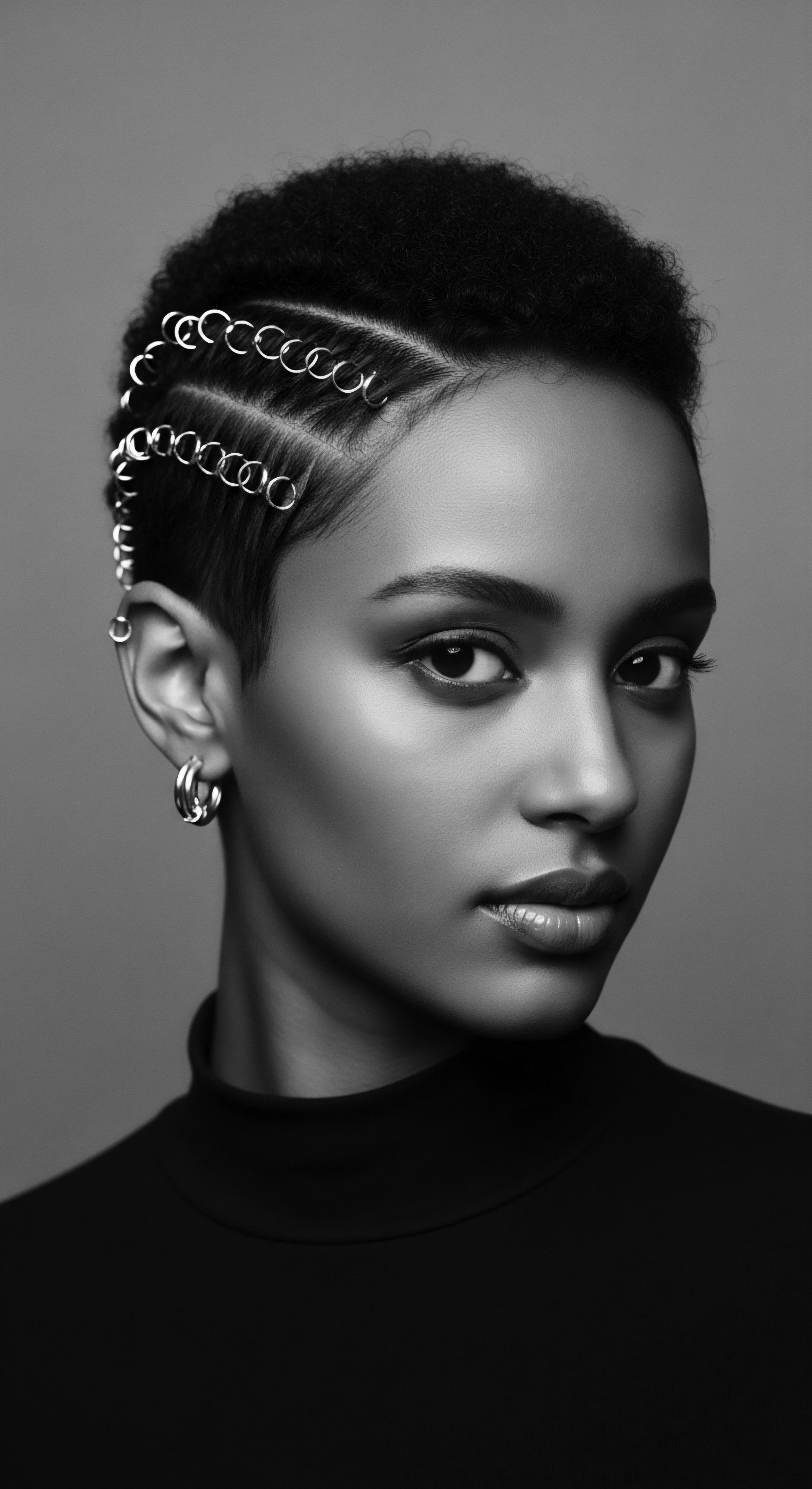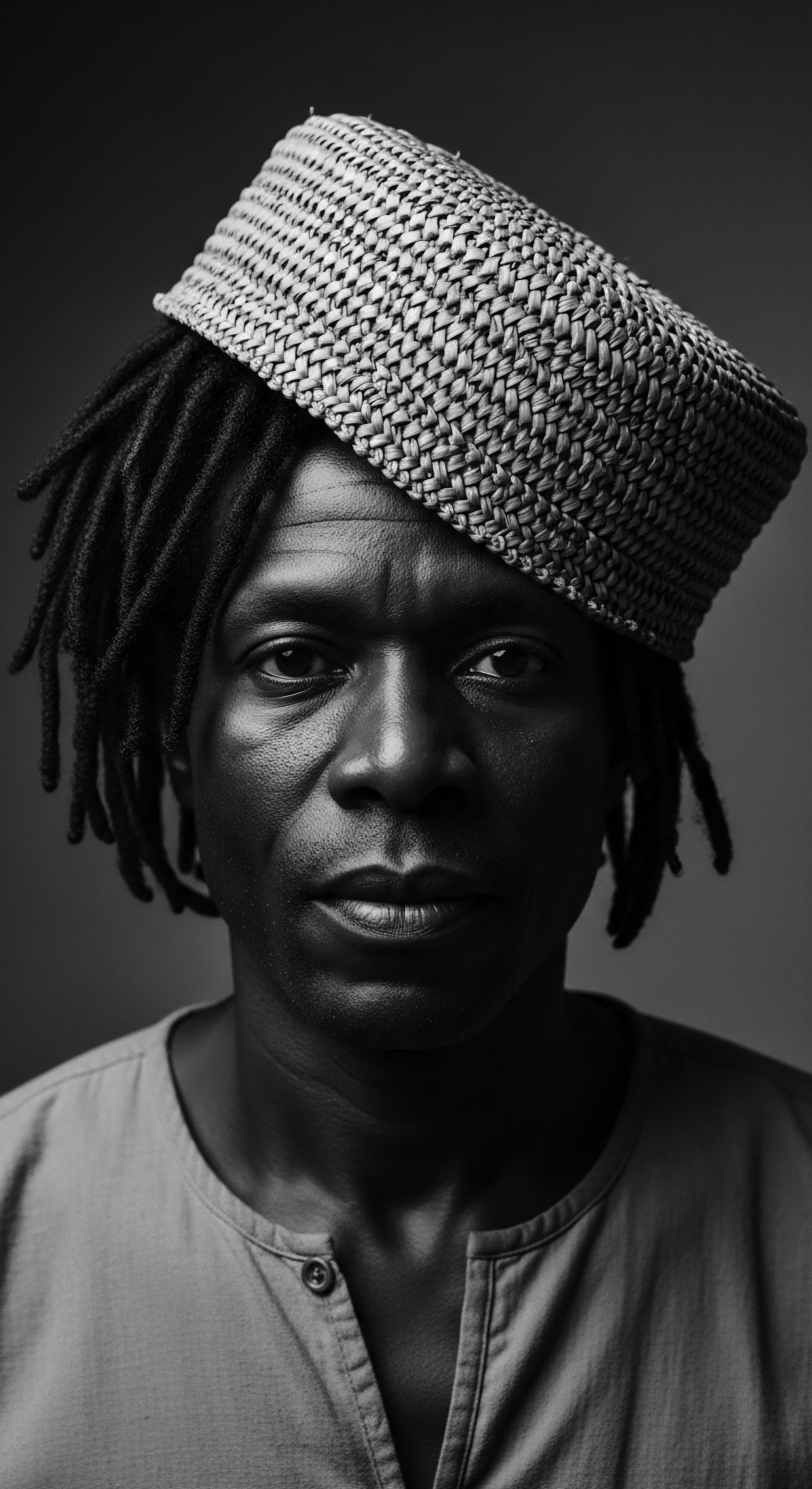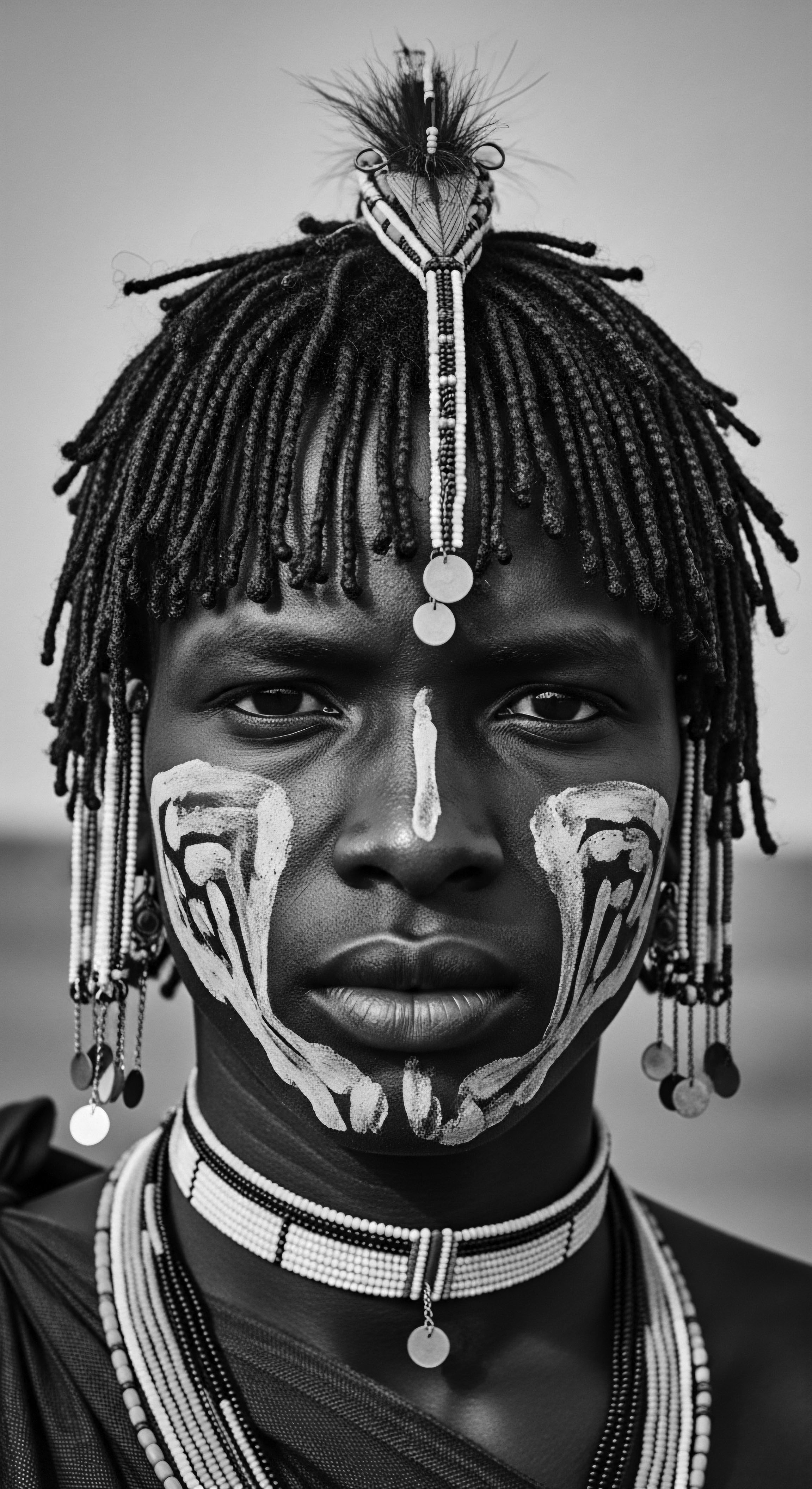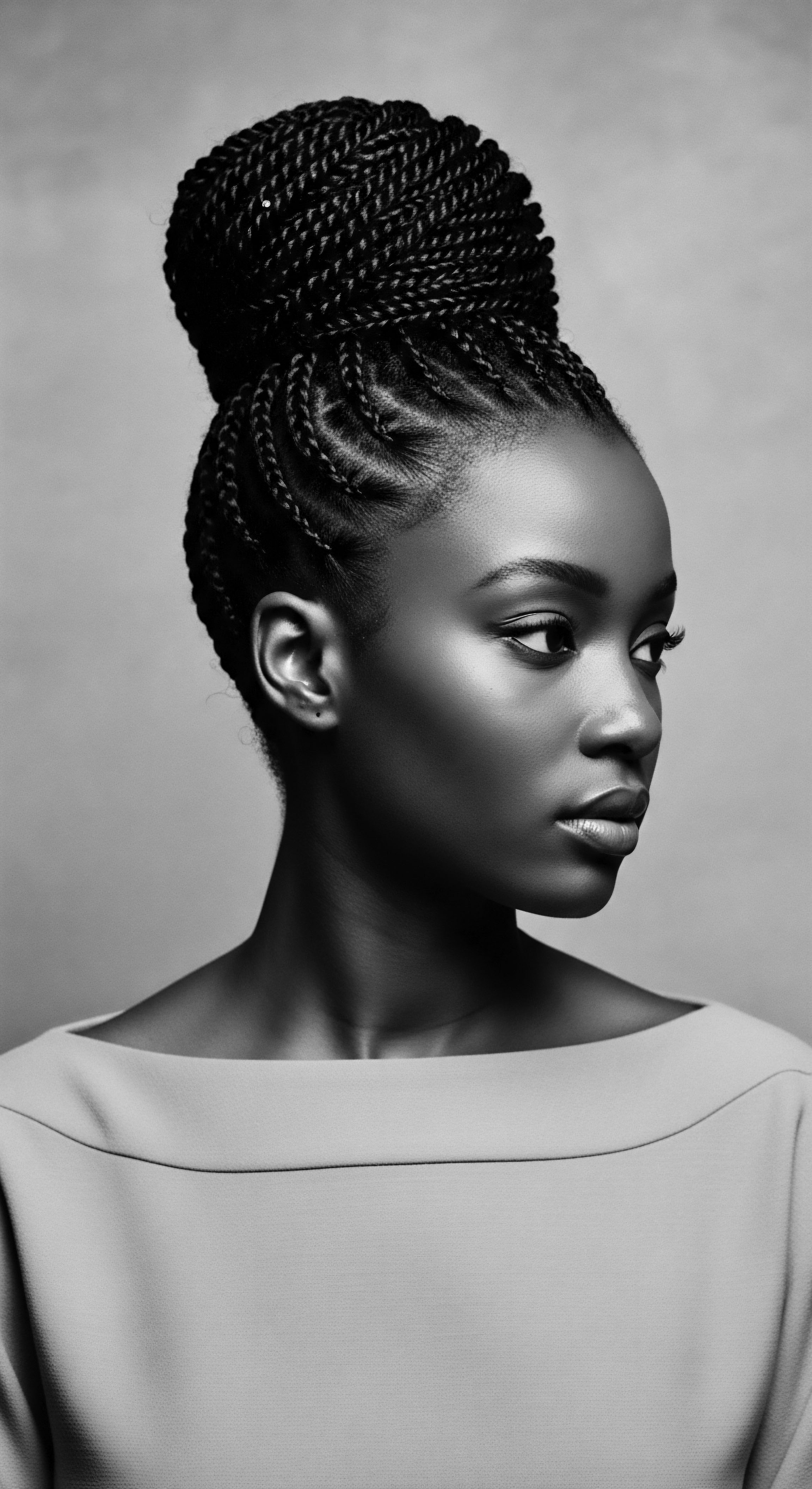
Fundamentals
The concept of Spiritual Headwear extends far beyond simple adornment. It holds profound significance, particularly within the vast and varied tapestry of textured hair traditions. This category of head covering, whether a meticulously wrapped cloth, a carefully shaped cap, or a sacred headdress, serves as a tangible link to ancestral practices and a visible declaration of identity.
Its meaning stems from both practical considerations and a deep reverence for the hair itself, recognizing its inherent spiritual connection. From shielding delicate strands from the elements to signifying social standing or spiritual devotion, the practice of covering the head has always held layers of cultural and personal importance.
Across diverse communities, especially those with Black and mixed-race heritage, headwear has served as a silent language, communicating volumes without a spoken word. It can speak of one’s lineage, marital status, age, or even a particular spiritual observance. The fabrics selected, the colors chosen, and the specific wrapping techniques employed often carry generations of communal knowledge. This knowledge ensures that a simple piece of material becomes a vessel for history and communal understanding, providing a grounding force for those who wear it.
At its basic interpretation, Spiritual Headwear is any covering worn on the head with an awareness of its deeper, symbolic connection to one’s inner self, one’s community, or one’s spiritual path. This designation moves beyond mere fashion, pointing to a deliberate act of protection, reverence, or expression tied to something beyond the physical realm. The care taken in selecting and applying such headwear often mirrors the care given to the textured hair beneath, creating a holistic approach to self-presentation that honors heritage.

Historical Roots and Everyday Purpose
Long before the advent of modern hair care, communities across Africa and the diaspora adopted head coverings for practical reasons. These included protection from harsh sun, wind, and dust, safeguarding the hair and scalp from environmental elements. The practice kept hair tidy during daily tasks, preserving intricate styles or maintaining cleanliness.
Yet, even in these functional applications, there lingered a sense of respect for the hair, recognizing its vulnerability and requiring thoughtful attention. This elemental biology of hair protection became intertwined with its cultural and spiritual significance over centuries.
The lineage of Spiritual Headwear traces back to ancient societies. Early uses in African communities, dating back thousands of years, demonstrate that these coverings were never solely about protection or practicality. They were a visual means of communication, reflecting social standing, wealth, and community affiliation.
For example, archaeological evidence suggests headwrap traditions were present in the Kingdom of Ghana as early as 300-1200 CE, crafted from locally woven materials with region-specific patterns. This early period laid the groundwork for the rich diversity of headwear that would follow.
Spiritual Headwear serves as a fundamental expression of identity, connection, and care, reflecting ancient practices and cultural meanings for textured hair.
As populations moved and traditions adapted, the simple head covering evolved into a profound statement. In many West African cultures, the precise folding, material, and design of headwraps, such as the Gele in Nigeria or the Duku in Ghana, signaled various social messages, including marital status, age, social position, or religious observance. This non-verbal communication system highlights the deep integration of headwear into societal structures, making it an indispensable part of cultural expression for many generations.
The initial understanding of Spiritual Headwear begins with acknowledging its dual nature ❉ practical utility and symbolic depth. It represents a conscious decision to clothe the hair, honoring its vitality while communicating a deeper allegiance to heritage and belief.

Intermediate
Moving beyond its fundamental understanding, Spiritual Headwear represents a living archive of community memory, particularly for those with textured hair. Its practice extends beyond simple covering, signifying a complex interplay of identity, historical resilience, and deep-seated cultural reverence. These coverings transform pieces of fabric into powerful symbols, expressing narratives of survival, celebration, and belonging that have traveled through generations and across continents. The deliberate act of donning such headwear becomes a daily ritual, a reaffirmation of a heritage that values textured hair as a sacred aspect of the self.
The cultural designation of headwear varies immensely. In some African societies, the particular wrapping style might convey specific social information, such as marital status or a connection to a religious observance. In contrast, in diasporic communities, head coverings often symbolize resistance against oppressive beauty standards, becoming an act of self-acceptance and a public declaration of one’s inherent worth. This distinction underscores the adaptability of Spiritual Headwear, allowing it to serve both traditional and counter-hegemonic purposes within various historical and social contexts.

Symbolism and Societal Dialogue
The symbolism embedded within Spiritual Headwear is rich and multifaceted. For many in the African diaspora, the headwrap or other coverings serve as a visual testament to cultural continuity despite historical disruptions. They function as crowns of dignity, worn not only for religious reasons but also to assert one’s presence and autonomy.
The communal act of headwrapping often becomes a shared language, where patterns, colors, and tying styles denote shared experiences and collective aspirations. It forms a visual conversation within a community, reinforcing bonds and recognizing shared ancestral paths.
This type of headwear also initiates a subtle, yet powerful, dialogue with broader society. It communicates a choice to honor natural hair, resisting pressures to conform to Eurocentric beauty ideals that have historically devalued textured hair. This act of public affirmation speaks to the deep psychological and social dimensions of hair for Black and mixed-race individuals. It underscores how hair is not merely an aesthetic feature but a deeply personal, often politicized, aspect of identity and self-worth.
Spiritual Headwear operates as a complex language, conveying identity, heritage, and resilience within and beyond textured hair communities.
Moreover, for textured hair specifically, certain head coverings provide tangible benefits that align with ancestral wisdom of protective styling. Wrapping hair can shield delicate strands from environmental damage, retain moisture, and minimize friction that might lead to breakage. This practical advantage, rooted in ancient practices, provides a scientific basis for the enduring wisdom of these traditions. It reveals how protective methods developed by ancestors intuitively addressed the biological needs of textured hair, long before modern scientific classification.

Diverse Expressions Across the Diaspora
The diverse expressions of Spiritual Headwear across the African diaspora illustrate its adaptability and enduring significance. Each region, influenced by unique historical trajectories and cultural fusions, developed distinct traditions.
- West African Gele ❉ The elaborate gele, prevalent among Yoruba and Igbo women in Nigeria, signifies celebration and social standing. The intricacy of the wrap often corresponds with the wearer’s status for special occasions.
- Caribbean Tignon ❉ In Caribbean cultures, particularly Louisiana, the tignon emerged partly as a response to colonial oppression. These wraps later transformed into symbols of cultural pride and resistance, demonstrating remarkable artistry in the face of restrictive laws.
- South African Doek ❉ The doek in South Africa represents dignity, especially during periods of immense social struggle, serving as a sign of resilience for Black women.
- Diasporic Headwraps ❉ Across various parts of the Americas, headwraps became a functional element of daily life. They also served as a profound reminder of ancestral homeland and a symbol of survival and communal identity, evolving into a uniform of rebellion against loss of self-definition.
These varied applications reinforce the understanding that Spiritual Headwear is not a static concept. It is a dynamic cultural practice, continuously reinterpreted and reaffirmed, yet always rooted in the profound connection between textured hair, personal identity, and the enduring legacies of shared heritage.
| Historical Period/Context Pre-Colonial Africa (Ancient) |
| Primary Significance for Textured Hair Symbol of identity, status, spirituality, and tribal affiliation; practical protection from elements. |
| Historical Period/Context Transatlantic Slave Trade (Forced) |
| Primary Significance for Textured Hair Imposed covering as a mark of enslavement and inferiority; a forced uniform of labor. |
| Historical Period/Context Post-Slavery/Colonial Era (Reclamation) |
| Primary Significance for Textured Hair Transformed into symbols of resistance, cultural pride, and beauty against oppressive laws (e.g. Tignon Laws). |
| Historical Period/Context Modern Diaspora (Contemporary) |
| Primary Significance for Textured Hair Expression of self-acceptance, connection to heritage, protective styling, and fashion statement. |
| Historical Period/Context The journey of headwear reflects the adaptability and enduring spirit of communities with textured hair, turning constraint into cultural assertion. |
The intermediate understanding acknowledges the deep interplay between practical care, cultural meaning, and historical resistance, recognizing Spiritual Headwear as a vital component in the ongoing narrative of textured hair heritage.

Academic
The academic understanding of Spiritual Headwear demands a rigorous and interdisciplinary examination, moving beyond popular interpretations to consider its profound socio-historical, psychological, and biological implications, especially concerning textured hair. This is an investigation into a cultural artifact that serves as a complex semiotic system, a tool of resistance, and a component of ancestral care practices. Its significance within Black and mixed-race communities is not merely aesthetic; it is an intrinsic element of identity construction, collective memory, and spiritual observance. The head, as the body’s highest point, has often been regarded as a channel for spiritual energy in many African traditions, thus making coverings for it particularly potent.
The very act of covering or adorning the head, particularly with attention to textured hair, signifies a deliberate engagement with a system of meaning. Scholars posit that hair itself, for individuals of African descent, serves as a comprehensive language system, relaying age, wealth, profession, relationship status, and religious conviction. Spiritual Headwear, then, acts as a primary lexicon within this language, its various configurations and materials articulating a rich cultural grammar that has persisted despite centuries of forced displacement and systemic oppression.

Psycho-Historical Dimensions and Resistance
From a psycho-historical standpoint, Spiritual Headwear cannot be divorced from the traumatic experiences of slavery and colonization, particularly the intentional denigration of Black hair. European beauty standards, enforced through various social and legal mechanisms, aimed to dismantle indigenous aesthetic values and control the identity of enslaved and freed Black individuals. In this context, head coverings were sometimes imposed as badges of servitude, intended to strip individuals of their dignity and aesthetic self-expression.
A powerful instance of this imposition and subsequent reclamation can be observed in the Tignon Laws of 1786 in Spanish colonial Louisiana . Governor Esteban Rodríguez Miró issued a decree mandating that free women of color in New Orleans cover their hair with a tignon, a scarf or handkerchief, and avoid “excessive attention to dress.” This legislation explicitly aimed to curb what white society perceived as the excessive beauty and social influence of free Black women, whose elaborate hairstyles and adorned heads were attracting white male suitors and challenging the established racial hierarchy.
However, the response of these women stands as a remarkable testament to creative resistance and the enduring spirit of heritage. Instead of being a mark of degradation, the tignon was transformed. Women of African descent, both enslaved and free, used colorful, luxurious fabrics and adopted intricate, sculptural wrapping techniques, often adorned with feathers and jewels, thereby making the tignon a symbol of their beauty, wealth, and defiant creativity. As historian Carolyn Long noted, the tignon became “a fashion statement,” with “bright reds, blues, and yellows of the scarves, and the imaginative wrapping techniques employed by their wearers, are said to have enhanced the beauty of women of color” (Long, as cited in The Wrap Life, 2018).
This historical example underscores a crucial aspect of Spiritual Headwear ❉ its capacity to be re-appropriated and infused with deeper meaning, transforming a tool of oppression into an emblem of cultural pride and self-determination. The initial intent to obscure Black women’s beauty backfired, solidifying the headwrap as a potent symbol of resilience for generations.
The Tignon Laws, intended to diminish the standing of free Black women, instead became a canvas for their defiant artistry, transforming forced head coverings into expressions of vibrant cultural identity.
This historical episode also highlights the long-term consequences of racial bias on textured hair. The policing of Black hair, manifested through laws like the Tignon Laws, continues to resonate in contemporary society, contributing to anxieties, internalized racism, and even discrimination in academic and professional settings. Understanding Spiritual Headwear through this historical lens allows for an appreciation of its deep protective function, both physically and culturally, against ongoing systemic pressures.

Biological and Holistic Considerations
From a biological perspective, Spiritual Headwear, particularly for textured hair, aligns with ancient wisdom regarding hair health. Textured hair, characterized by its unique coil and curl patterns, possesses specific structural properties that make it susceptible to dryness and breakage. Traditional head coverings, especially those made of smooth materials like silk, help to retain moisture, reduce friction against coarser fabrics (like cotton pillowcases), and protect hair from environmental stressors such as harsh sun or extreme temperatures. This intuitive understanding of hair biology was woven into ancestral hair care rituals, long before microscopic analysis of hair shafts.
The practice of covering the head also protects the scalp. Consistent exposure to environmental pollutants or harsh weather can affect scalp health, which in turn impacts hair growth. Head coverings provide a barrier, maintaining a more stable microclimate for the scalp.
However, academic discussions also acknowledge that improperly worn or excessively tight headwear, or unhygienic practices, can contribute to conditions like traction alopecia, especially for individuals with Afro-textured hair which may have fewer elastic fibers attaching follicles to the dermis. This scientific understanding reinforces the need for culturally sensitive care practices within a holistic framework.
Moreover, the holistic practitioner’s perspective posits that hair is not merely a biological appendage but an extension of one’s spiritual and energetic body. In many African spiritual traditions, hair is viewed as a conduit to ancestral wisdom and a receiver of cosmic energies. Therefore, covering it can be an act of reverence, a means of preserving one’s spiritual energy, or a protective measure against negative influences. The choice of material, color, or even the direction of wrapping may hold specific energetic intentions, passed down through generations.
The careful attention paid to hair through techniques such as scalp oiling, documented in ancient Indian Ayurveda, parallels the protective function of headwear. These practices, though varied in origin, share a common ancestral thread ❉ a recognition of the hair’s vitality and its connection to overall well-being.
| Dimension of Study Socio-Historical |
| Relevance to Spiritual Headwear and Textured Hair Communicates social status, identity, and serves as a means of cultural resistance against oppression. |
| Academic or Ancestral Perspective Anthropological studies on sumptuary laws; historical accounts of reclamation and symbolic meaning. |
| Dimension of Study Psychological |
| Relevance to Spiritual Headwear and Textured Hair Impacts self-perception, confidence, and collective identity; a vehicle for self-expression and mental well-being. |
| Academic or Ancestral Perspective Psychology of Black hair and identity; studies on discrimination and self-esteem. |
| Dimension of Study Biological/Physiological |
| Relevance to Spiritual Headwear and Textured Hair Provides protective styling benefits (moisture retention, friction reduction); considerations for scalp health. |
| Academic or Ancestral Perspective Dermatological research on hair structure, traction alopecia, and environmental impact. |
| Dimension of Study Spiritual/Metaphysical |
| Relevance to Spiritual Headwear and Textured Hair Seen as an antenna for spiritual energy, connection to ancestors, and a site for sacred rituals. |
| Academic or Ancestral Perspective Ethnobotanical studies; folklore and traditional belief systems in African cultures. |
| Dimension of Study Understanding Spiritual Headwear requires a synthesis of these dimensions, recognizing its enduring power across different spheres of human experience for textured hair. |

Interconnected Incidences and Modern Resonance
The incidences surrounding Spiritual Headwear extend into contemporary dialogues on racial identity, beauty standards, and cultural appropriation. As natural hair movements gain prominence globally, the headwrap has seen a resurgence, chosen not out of coercion but as a conscious affirmation of ancestral roots and a deliberate move away from Eurocentric ideals. This modern resurgence is a testament to the unbroken lineage of care and meaning associated with Spiritual Headwear, demonstrating how historical practices remain vibrantly alive in present-day expressions.
The meaning of Spiritual Headwear continues to evolve, yet its core remains steadfast ❉ a profound reverence for textured hair and its historical narrative. This enduring connection underscores the belief that caring for one’s hair is deeply intertwined with respecting one’s heritage, affirming identity, and acknowledging an ancestral continuum. Through rigorous academic inquiry, we gain a more complete description of its deep roots, complexities, and ongoing relevance for Black and mixed-race communities worldwide.
A comprehensive statement on Spiritual Headwear acknowledges it as an intricate practice and cultural artifact, often a piece of fabric, that covers or adorns the head, embodying a complex interplay of historical resilience, spiritual devotion, and protective care for textured hair, particularly within Black and mixed-race diasporic communities, serving as a powerful, evolving symbol of identity, cultural continuity, and self-affirmation against systemic pressures.

Reflection on the Heritage of Spiritual Headwear
To consider Spiritual Headwear is to walk through a vibrant gallery of human resilience and creativity. It stands as a living testament to the ancestral ingenuity that found purpose, power, and beauty in the very act of adorning the head. For textured hair, in particular, these coverings represent more than stylistic choices; they are whispered histories, silent prayers, and steadfast declarations of selfhood in a world often seeking to diminish it. This profound connection reaches back to continents where hair communicated entire life stories, serving as a unique identifier for lineage, status, and spiritual alignment.
The journey of Spiritual Headwear, from the warmth of an ancestral home to the complexities of a new diaspora, speaks volumes about adapting and preserving. It teaches us that true care extends beyond the tangible, moving into realms of spirit and memory. Each knot tied, each fabric chosen, each style crafted carries the wisdom of those who came before, reminding us that even in the face of immense challenge, the spirit of heritage finds ways to flourish. It becomes a personal conversation with history, a tactile link to shared experiences that transcend time.
Contemplating the continuous presence of Spiritual Headwear in diverse communities, we recognize its enduring power to shape individual and collective narratives. It remains a dynamic expression of cultural pride, a protective shield both literal and symbolic, and a beautiful affirmation of the textured hair that grows from rich, ancestral soil. The ongoing practice of honoring hair in this manner ensures that the soul of a strand, rooted in deep heritage, continues its resonant song across generations, an unbreakable helix connecting past, present, and future.

References
- Byrd, Ayana D. and Lori L. Tharps. Hair Story ❉ Untangling the Roots of Black Hair in America. St. Martin’s Press, 2001.
- Dabiri, Emma. Twisted ❉ The Tangled History of Black Hair Culture. HarperCollins, 2020.
- Banks, Ingrid. Hair Matters ❉ Beauty, Power, and Black Women’s Consciousness. New York University Press, 2000.
- Johnson, Terri, and Terrell Bankhead. “Hair It Is ❉ Examining the Experiences of Black Women with Natural Hair.” Open Journal of Social Sciences 2, no. 1 (2014) ❉ 86-100.
- Mbilishaka, Thema. “PsychoHairapy ❉ Brushing Up on the History and Psychology of Black Hair.” Psi Chi, 2018.
- Long, Carolyn. (Cited in “Tignon Law” and “Colorful Protest” sections in The Wrap Life, 2018).
- Gould, Virginia M. (Cited in Wikipedia, 2025; reframe52, 2024; The Wrap Life, 2018).
- Alhanshali, Sarah, et al. “Religious headwear and alopecia ❉ considerations for dermatologists.” International Journal of Women’s Dermatology 9, no. 4 (2023) ❉ e097.
- Rosado, Sybille. “Among Women of African Descent, Hair and Hairstyles are Evidence of a Set of Rituals that are Being Practiced throughout the Diaspora.” Research in African Literatures 34, no. 2 (2003) ❉ 60-70.
